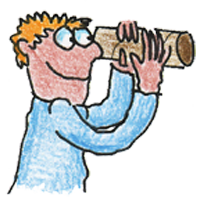What if you use two eyes to look across a room but one eye is looking through a cardboard tube?
How does the tube change what you see?
 |
Hold a cardboard tube in front of your left eye. Place your right hand in front of your right eye, next to the tube. Look straight ahead with both eyes. One eye sees through the tube while the other eye sees your hand. Information from each eye is sent to your brain. It’s interpreted as a hole in your hand. |
Further Explanation from The Exploratorium: Some people find that this effect is stronger with one eye compared to the other. That’s because one eye is likely dominant, which means your brain has a slight preference for visual information from that eye over the other. This is similar to being left- or right-handed, although your eye and hand preference don’t necessarily match!Â
Change the activity. Use a larger, smaller, shorter, or longer tube. Use a tube made out of paper instead of cardboard. Look to one side instead of straight ahead.
Quick Science suggestions take minimal prep time and use common materials.

I think it would be fun to see if what children experience changes if they used a tube made from wax paper. If it lets in a bit of light would that change the illusion?